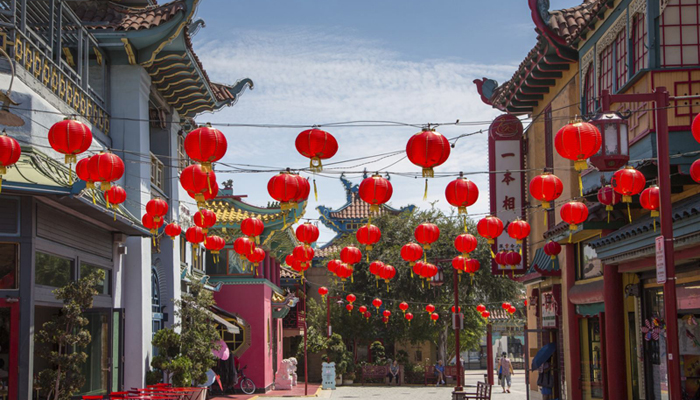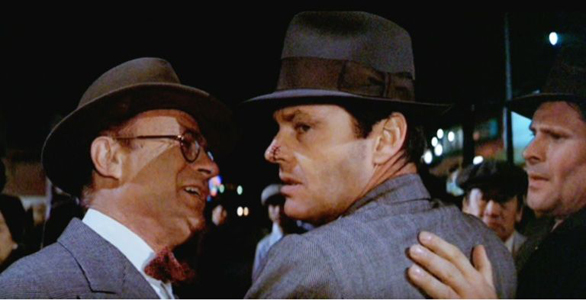


| 
|
 |
About a year ago, I went back to school. Nothing crazy, just for a marketing certificate (on the company's dime). I attended Wilmington University (go Wildcats!) in Delaware... virtually, of course. The class was BMK 320, Consumer Behavior. I can't recall exactly what the origin of the assignment was, but I ended up writing a piece on a subject I found very fascinating: Chinatown in Los Angeles. So yes, I gave my east coast instructor an education on a west coast Chinatown... for a marketing class. The instructor's name was Jock Sommese (that'll be important at the end of the paper). I tied it all together and ended up with an A in the class, so it must have worked. Nonetheless, I still find this topic interesting so I'm going to share you with now. Yes, I'm leaving all the footnotes and references in there. It was a college paper after all. Enjoy!  A conversation occurred on New Year's Day between my wife and my young cousin at a family get-together. I wasn't privy to the lead-up, but my wife turned to me and said, "New Chinatown?" My cousin, who is quite the connoisseur of ethnic cuisines, sought to clarify whether we usually visit Old Chinatown or New Chinatown for our culinary adventures. I informed my wife that the old Chinatown was the one in Los Angeles (which in all honesty, we had not been to in 7-8 years), while the new one is growing in the San Gabriel Valley (which we have yet to visit). That exchange turned out to be the genesis of this paper. I've been hearing of the rise of the San Gabriel Valley's profile in the Chinese community. Word is that tourists from China would use it as their home base while they vacationed, not only in southern California, but the whole of the United States. This got me thinking... how had the San Gabriel Valley claimed the title of "New" Chinatown? What's going on with "Old" Chinatown? Has there been such a decline of Los Angeles' Chinatown that it more-or-less lost (or is losing) its position as the epicenter of the Chinese subculture to the neighboring suburbs of Alhambra, Monterey Park, and San Gabriel? And for the purposes of this paper, can I answer these questions with concepts we've learned about in class? To begin, if we seek to be correct on nomenclature, the ethnic enclave in the San Gabriel Valley should really be called "New NEW Chinatown." A bit of history... the original Chinatown can be traced back to 1870 in Los Angeles and was nothing more than a collection of unpaved alleys, east of Alameda Street. The residents here were "mainly laundrymen, market gardeners, agricultural and ranch workers, and road builders" (chinatownla.com, n.d.). Due to increasing rents from white landlords, worsening poverty of the Chinese residents, a rise in anti-Chinese sentiment, and the final purchase of the land to turn that area into what is now Union Station - the main railroad terminal in Los Angeles - Chinatown version 1.0 ceased to exist by 1910. The desire to find a new enclave for the displaced Chinese resulted in a new settlement about half a mile to the north-northwest, and in 1938, "New Chinatown" was born, where it still exists in its current location (chinatownla.com, n.d.). As a fun historical side note, New Chinatown displaced what was Los Angeles' version of Little Italy, which was never re-created. By the second half of the 20th Century, the "new" adjective fell off colloquial use and the area north of downtown Los Angeles was simply, Chinatown. This now brings us to the suburban cities of Monterey Park, Alhambra, and San Gabriel, all collectively in the San Gabriel Valley, about nine miles east of Los Angeles' Chinatown. They make up what I am calling "New New Chinatown." The transformation of these cities from sleepy suburbs to international hotspots is made possible by a real estate developer by the name of Fred Hsieh. Finding Los Angeles' Chinatown to be too crowded, he had a vision to create the "Chinese Beverly Hills" and ended up in Monterey Park. You could call that vision a success as Monterey Park became the only city in the United States with a population with an Asian majority (Oliver, M., 1999). Regretfully, much like the anti-Chinese sentiment that befell Chinatown version 1.0, the non-Asian residents of Monterey Park didn't take too kindly to having their community change so drastically and so quickly by the incoming Chinese. Bumper stickers declaring, "Will the Last American to leave Monterey Park please bring the American Flag," were spotted around town, and attempts were made to get English-only measures on a ballot to counter the proliferation of Chinese-language signs across the town (Fong, T. P., 1994, p. 112). Due to the pushback in Monterey Park, including limited-growth ordinances, Chinese immigrants branched out and in-roads were made into the neighboring cities of Alhambra and San Gabriel, which in turn, made more of the San Gabriel Valley a Chinese enclave. In Alhambra, Chi Mui, an immigrant from Hong Kong who come to the United States in 1963, became that city's first Chinese American mayor in 2006 (Pierson, D., 2006). With the backstory for the reader now in place, my wife and I decided to visit Los Angeles' Chinatown a few weeks ago. I did not go there for the purpose of this paper; I had gone for personal curiosities stemming from that New Year's Day conversation more than anything. But while I was there, it was apparent I had found my topic for this assignment. The last time we had visited was during the Lunar New Year celebration about 7-8 years ago. There was a parade, throngs of people, and a festival style atmosphere. This visit couldn't have been more different. On a Sunday around 5:00 p.m., Chinatown was dead. Most stores had closed, and only a small smattering of restaurants were open. It appeared rundown with several storefronts, not just closed, but empty. If you were to compare Los Angeles' Chinatown, to the standard-bearers in San Francisco and New York, the Los Angeles version would be a laughable embarrassment. The most jarring loss was the closure of Fung's. In my personal experience, Wing Hop Fung was the quintessential Chinese grocery and marketplace. From loose-leaf tea by the ounce to Chinese delicacies to traditional supplies and products, Fung's was the location to find it. It occupied a two-story location at the heart of the enclave. To see that space empty felt like the area was legitimately on a downward path. At first, my wife suggested that maybe there was an "old man" that was running the establishment who passed away and the kids didn't want to run the business anymore. As many older businesses in ethnic enclaves, not just Chinatown, are family-run operations, it was a reasonable, yet still disappointing hypothesis. Alas, that is not the case. If you look at Wing Hop Fung's website, you'll find that their office and warehouse is still in Los Angeles' Chinatown, but their only locations are now in Monterey Park and Arcadia, also in the San Gabriel Valley (winghopfung.com, n.d.). Let's apply some of our class learning to this. If we were to examine how the four P's could have affected this business decision, this is clearly an issue of Place. To be fair, I don't know the real reason Wing Hop Fung closed its Chinatown location, but based on surface observations, this is easily a case of a firm going to where their customers are, and leaving a place where they aren't. To tie in to our book for this class, we should look at what Mothersbaugh and Hawkins (2016) call exposure. "Exposure occurs when a stimulus is placed within a person's relevant environment" (p. 275). If you're selling traditional Chinese wares, primarily aimed at Chinese consumers, you should go to where Chinese people are so you can expose them to your products and services. At one point, Los Angeles' Chinatown was that location. Apparently, that isn't the case anymore. Fung's is making the smart business decision to close a location that is underperforming and/or no longer sustainable. This bring us to the heart of this paper. Why aren't Chinese people in Chinatown anymore? Locally, "the first wave of Chinese Americans who moved to Monterey Park were commonly young professionals eager to move out of Los Angeles' Chinatown and assimilate into an integrated suburban life" (Fong, T. P., 1994, p. 25), while those coming from China "arrived with education, professional skills, strong political and class ideologies, and in some cases, capital. The crowded and unattractive Los Angeles Chinatown would not suit these affluent newcomers" (Fong, T. P., 1994, p. 31). These arguments may bear weight as Los Angeles' Chinatown is less that one square mile, and made up of a patchwork of buildings that were erected over the decades that were probably contemporary-looking when built, but look horribly dated now, especially juxtaposed to each other. We know that Fred Hsieh picked Monterey Park to be the "Chinese Beverly Hills," but what was the key to have that idea blossom into a long-lasting reality? To answer this, we must look at Chapter 5 of Consumer Behavior: Building Marketing Strategy by Mothersbaugh and Hawkins (2016). In it, they talk about how to best market to various ethnic subcultures, including Asian Americans. "One estimate is that 80 percent of Asian Americans can be reached with 'in-language' promotions" (p. 163). In other words, to best reach Asians, you should speak their language. In Timothy Fong's book, The First Suburban Chinatown: The Remaking of Monterey Park, California (1994), he mentions the drive of some residents to push for English-only storefront signage because as "the number of Chinese businesses grew, the number of Chinese-only signs increased... and those that did include English offered little more than a token translation" (p. 110). The businesses in Monterey Park were targeting and catering to their preferred clientele, both the Chinese residents of the city, as well as Chinese immigrants and tourists. Compare that environment to that Los Angeles' Chinatown where, from personal experience, the bulk of the signage there was English-first, if not English-only. Aside from some small pagoda-style accoutrements on the bank and gas station, you could not truly tell you were in Chinatown. It could have been any neighborhood. When looking at other Asian ethnic enclaves in the Los Angeles area, like Koreatown or Little Saigon, the native language-first strategy is proving to be key to their success. Storefront signage is primarily in Korean and Vietnamese, respectively, and both enclaves are thriving. On the Sunday that we visited Los Angeles' Chinatown, we swung by Little Tokyo as well, a single mile away. While the Chinese enclave pretty much had rolled up their sidewalks at sunset, the Japanese enclave was still bustling at 9 p.m. To have a more apples-to-apples comparison, let's reflect on the following quote from Alhambra Chamber of Commerce President Mark Paulson, "Valley Boulevard has become kind of like a Chinatown east, as opposed to the Chinatown in downtown L.A. It has become quite the landmark, (the restaurants) are regularly featured in culinary articles about restaurants and so forth" (Gold, L., 2012). Indeed, when holding that statement up to what I personally saw in Los Angeles' Chinatown, the only restaurant with any activity - a two-hour wait to give a gauge of its popularity - was Howlin' Ray's, a restaurant specializing in Nashville Hot Chicken. Not exactly what you find on a traditional Chinese bill of fare. Chinatown is failing because it's no longer really Chinese oriented. Regretfully, Los Angeles' Chinatown has turned into a tourist trap with no real signs on change. With that said, there is some development underway, but it's not intended for Chinatown's improvement. With the gentrification of downtown Los Angeles well underway, there is a demand for more housing in the area, and Chinatown is a prime place to build. But again, this isn't for the benefit of Chinatown. A new complex with over 900 apartments is in planning stages, but the developers "have not committed to providing a set amount of affordable units in the project. That was a major pressure point as Chinatown is overwhelmingly low-income" (Barragan, B., 2018). Much like how one of the reasons that lead to Chinatown version 1.0 demise was the increasing poverty of its residents, those same forces are rearing their head here and may befall its successor. Compare those socio-economics to the San Gabriel Valley which has "a flourishing Asian commercial district with more than 100 Asian restaurants and multistoried, Mediterranean-style shopping plazas featuring noodle shops next to appointment-only jewelry stores selling $40,000 watches" (Pierson, D., 2006), and the faltering of Los Angeles' Chinatown should be even less surprising that it is. Chinese people and Chinese money are simply going elsewhere. To tie one last concept from our class into this paper, Monterey Park, and the San Gabriel Valley as a whole benefited by the Intercept Strategy that Fred Hsieh implemented. As Mothersbaugh and Hawkins (2016) wrote, "If the target market engages in limited decision making and the brand is not part of the evoked set, the objective will be to intercept the consumer during the search for information" (p. 541). Fred Hsieh did that by marketing Monterey Park directly to people in China, and he boasted his success by saying, "The Chinese people, they don't know San Diego or Washington, D.C. But they know Los Angeles and they know New York and they know Monterey Park" (Oliver, M., 1999). To recap... How had the San Gabriel Valley claimed the title of "New" Chinatown? By offering an alternative to the crowded Chinatown, creating a Chinese Beverly Hills, and doing so primarily by catering to the Chinese, in their native Chinese language. What's going on with "Old" Chinatown? Literally nothing, except growing old and stale. Has there been such a decline of Los Angeles' Chinatown that it more-or-less lost its position as the epicenter of the Chinese subculture to the neighboring suburbs of Alhambra, Monterey Park, and San Gabriel? The answer has to be an unqualified yes. Did I answer these questions with concepts we've learned about in class? Forget it, Jock. It's Chinatown.  REFERENCES Fong, T. P. (1994). The First Suburban Chinatown: The Remaking of Monterey Park, California. Philadelphia, PA: Temple University Press. Mothersbaugh, D. L. & Hawkins, D. I. (2016). Consumer Behavior: Building Marketing Strategy (13th ed.). New York, NY: McGraw-Hill Education. Chinatown Los Angeles. (n.d.). Retrieved from: http://chinatownla.com/wp1/history/ Wing Hop Fung. (n.d.). Retrieved from: https://winghopfung.com/pages/store-locations Oliver, M. (1999, August 12). Developer Who Saw Monterey Park as 'Chinese Beverly Hills' Dies. Los Angeles Times. Retrieved from: http://articles.latimes.com/1999/aug/12/local/me-65010 Pierson, D. (2006, March 13). Dragon Roars in San Gabriel. Los Angeles Times. Retrieved from: http://articles.latimes.com/2006/mar/31/local/me-sangabriel31 Gold, L. (2012, May 26). Valley Boulevard: A window into the 'new Chinatown'. San Gabriel Valley Tribune. Retrieved from: https://www.sgvtribune.com/2012/05/26/valley-boulevard-a-window-into-the-new-chinatown/ Barragan, Bianca. (2018, February 13). Huge Chinatown development with no affordable housing skewered by neighbors. Curbed: Los Angeles. Retrieved from: https://la.curbed.com/2018/2/13/17008336/chinatown-development-apartments-state-historic-park So they you have it. A quick history on the myriad of Chinatowns that exist(ed) in the Los Angeles area. Indeed I learned so much more by doing this paper, and I hope that by sharing it with you, you will have found it equally as enlightening. And perhaps, when this whole pandemic thing decides to wrap up, you can visit both locations and make your own comparisons. |
  Thanks for visiting. Love, Demosthenes Spiropoulos |